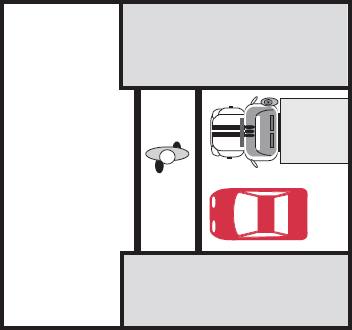Pavement Markings
Lines and symbols on the roadway divide lanes and tell you when you can pass other vehicles or change lanes. They also tell you which lanes to use for turns and where you must stop for signs or traffic signals. The arrows on these illustrations show the direction of traffic.
Solid lines along the side of the road tell you where its edge is - where the travel lane ends and the shoulder begins. It is illegal to drive across the edge line, except when told to by a police officer or other authorized official or when allowed by an official sign. An edge line that angles toward the center of the road shows that the road is narrower ahead. Lines that separate lanes of traffic that moves in the same direction are white.
Lines that separate traffic that moves in opposite directions are yellow. There may be two lines between lanes and lines can be solid or broken. Read Chapter 6 for the rules on how to pass other vehicles.

What some lane lines indicate:
One broken line: You can pass other vehicles or change lanes if you can safely and not interfere with traffic.

Solid line with broken line: If you are on the side with the solid line, you cannot pass other vehicles or go across the line except to make a left turn into a driveway. If you are on the side with the broken line, you can pass if it is safe to and you will not interfere with traffic.

Double solid lines: You can not pass or change lanes. You can not go across the lines except to turn left to enter or leave the highway (e.g., to or from a driveway or to do a U-turn see Chapter 5).

One solid line: You can pass other vehicles or change lanes, but you can only do so when obstructions in the road or traffic conditions make it necessary.

Stop and Crosswalk Lines: At an intersection controlled by a STOP sign, YIELD sign or traffic light, there can be a white stop line painted across the lane, and/ or two parallel lines or light, you must reach the stop line, if there is one, or the crosswalk. You need a stop line or crosswalk if required to by a light, sign or traffic officer, or to yield to a pedestrian, in-line skater or scooter at a marked or unmarked crosswalk. (See "Pedestrians" in Chapter 11).


Arrows: Arrows show which lanes you must use. In this illustration, for example, you can turn right only from the right lane. To go straight, you must use the left lane. You must be in the correct lane before you reach the solid line that separates the lanes.

Diamond Symbol: This symbol indicates reserved lanes for buses, HOV (High Occupancy Vehicles) like car-pools and van-pools, bicycles or other special vehicles. You cannot enter and use these lanes unless your vehicle complies with the occupancy or other requirements indicated by signs for the times the special conditions are in effect. When used to designate reserved lanes on city streets, sections of the solid white line that separates the diamond lanes from the normal lanes can be replaced by broken white lines. In these locations, non-HOV can enter the HOV lane if they make a right turn at the next intersection. Bus lanes and HOV lanes are to promote the most efficient use of limited street and highway capacity. They assure that vehicles with the highest importance move the fastest.

from: https://dmv.ny.gov/about-dmv/chapter-4-traffic-control-2#pav-mar
Nenhum comentário:
Postar um comentário